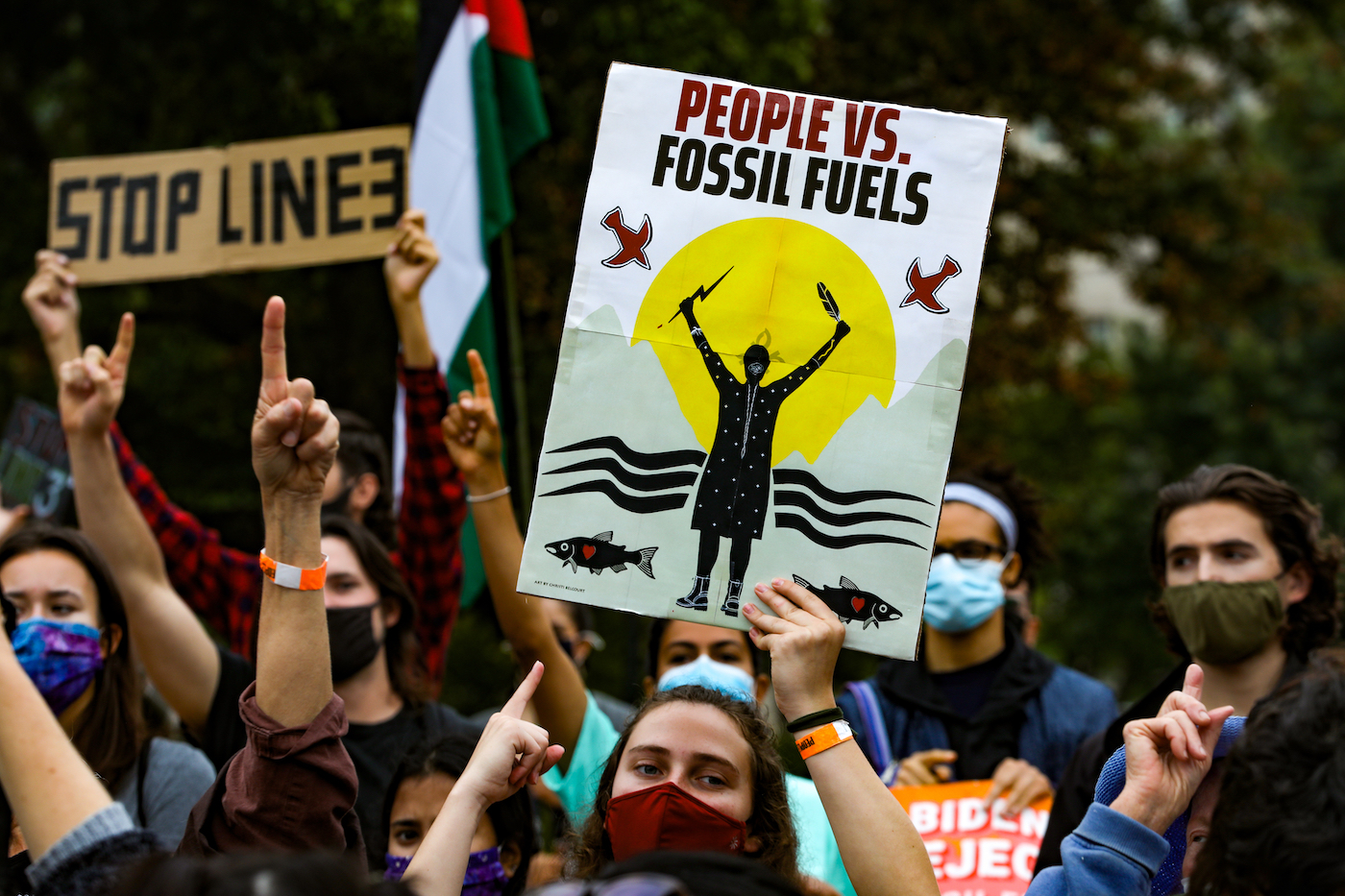Two years and a pandemic later, climate protests return to Washington
Oct 18, 2021
A total of 655 people were arrested in Washington, D.C., last week as they protested fossil fuel projects and demanded that President Joe Biden declare a climate emergency. Demonstrators began blocking the fence outside the White House on Monday, Indigenous Peoples’ Day, chanting and waving signs. On Thursday, Indigenous leaders sat on the floor of the Bureau of Indian Affairs, linking arms; activists sprayed fake oil on the steps of the U.S. Chamber of Commerce, sending pink and blue smoke plumes into the air. On Friday, youth activists formed a blockade in the road leading to the Capitol.
These “People vs. Fossil Fuels” protests, led by Indigenous organizers, included people resisting oil and gas projects all over the country, from Alaska to Appalachia. They were protesting not just climate change, but also water contamination and sexual assaults against Indigenous women associated with oil and gas projects.
Last week’s demonstrations were some of the largest climate protests in the United States since 2019. Similar scenes have played out abroad, pressuring governments ahead of the upcoming international climate negotiations in Glasgow, Scotland. In London, more than 500 activists with Extinction Rebellion, a civil disobedience group, were arrested at a protest last month, with actions quickly shut down by police. A few weeks later, the Fridays for Future movement, sparked by the Swedish activist Greta Thunberg, held its first big climate strike all year, with young people demonstrating in 1,500 locations around the world. Another climate strike is planned for later this week.
It’s early, but turnout hasn’t come anywhere near the levels of participation seen during the climate strikes in 2019, when 300,000 people protested in New York City alone. “I’m not sure we have seen any big protests since Biden was elected around climate here in D.C., or in the U.S. generally,” said Dana Fisher, a sociologist at the University of Maryland who studies activism and climate change.
There are a few explanations for this. One is the pandemic — people have been understandably more nervous about going outside their homes. Russell Chisholm has been leading an effort to stop construction of the Mountain Valley natural gas pipeline in Virginia and West Virginia. In the pre-pandemic times, organizing for the Mountain Valley Watch and other grassroots groups typically happened in person at churches and community centers. These days, it’s harder to meet in person, and a lack of reliable internet access in rural places makes it even harder to communicate, Chisholm said.
Shifting political winds have proven to be another damper: Instead of a climate denier in the White House, the country has a president who wants to do something about the climate crisis. “Historically, what we know is that when Democrats win, protests go down,” Fisher said. “The thing is, to get big protests out there, there needs to be an amazing amount of outrage about something.”
Still, there’s been plenty to protest. This summer, thousands marched to the Mississippi River in Minnesota to try and stop the construction of Enbridge’s Line 3 tar sands pipeline, which Indigenous groups in the Great Lakes say threaten their water and traditional practices like harvesting wild rice. Roughly 900 people have been arrested since construction began on the project, and oil started flowing through the pipeline at the beginning of this month.

While Biden canceled the Keystone XL pipeline extension in January, he has not moved to stop Line 3 and other projects. A recent report from Oil Change International found that canceling 24 proposed oil and gas projects could cut U.S. emissions by 1.6 billion metric tons of greenhouse gas emissions every year. For perspective, that’s one-fifth of the country’s total emissions in 2019.
“Biden declared himself as the ‘climate president,’” said Julia Bernal, with the Pueblo Action Alliance, who attended the protests in D.C. “And to us, it’s just been business as usual.” Bernal is working to stop fossil fuel projects in the Greater Chaco region in northwestern New Mexico, which she says have contaminated the air, water, and soil. Biden has not followed through on a campaign promise to ban new oil and gas leasing on public lands, though his administration issued a moratorium that Secretary of Interior Deb Haaland stressed was temporary.
“Of course we’re listening to advocates and people who have been elevating the issue of climate for decades,” said Jen Psaki, the White House Press Secretary, when asked about the protests at a press conference on Thursday. She pointed to the president’s legislative agenda being haggled over in Congress.
Protesters who attended the events in Washington, D.C., last week said there was a heavy police presence, with tasers and canine units. “When it comes to going to the front lines, seeing the cops, we know what to do,” said Tasina Sapa Win, a Lakota anti-pipeline organizer and co-founder of Cheyenne River Grassroots Collective, who has been protesting fossil fuel projects since the Standing Rock protests against the Dakota Access pipeline five years ago. “We know that our movement needs to stay as peaceful as possible.”
Bernal said that the protests brought back memories from these earlier efforts to stop pipeline projects. “But it’s also a nice reminder that, like each of our fights, we’re not alone,” she said. “It still was a moment for us to build with each other, and remind each other that we’re still fighting against the same thing.”
This story was originally published by Grist with the headline Two years and a pandemic later, climate protests return to Washington on Oct 18, 2021.